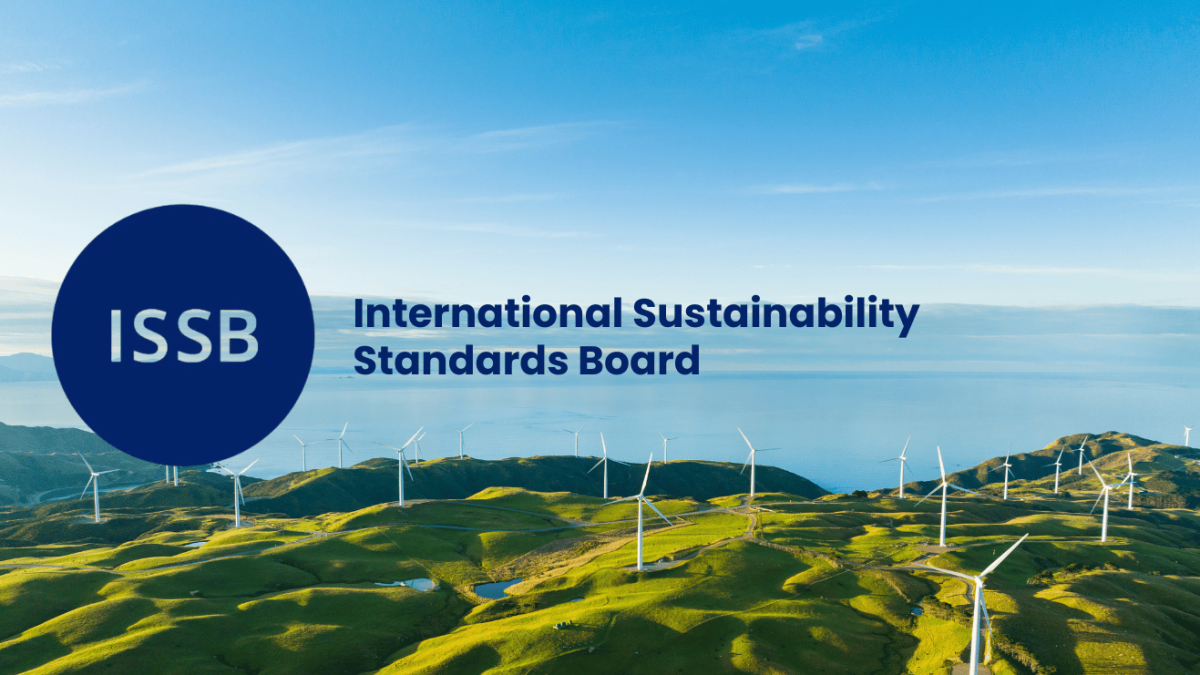The ISSB Standards: A Milestone in the Global Economy On 26th June, 2023, the ISSB finally launched its inaugural sustainability standards, ushering in a new era in international corporate reporting The International Sustainability Standards Board (ISSB) has issued its first two IFRS Sustainability Disclosure Standards: the IFRS S1, which provides a set of general disclosure requirements designed to enable companies to communicate to investors about the sustainability-related risks and opportunities they face over the short, medium and long term, and the IFRS S2 , which sets out specific climate-related disclosures and is designed to be used with IFRS S1.
On 26th June, 2023, the ISSB finally launched its inaugural sustainability standards, ushering in a new era in international corporate reporting
The International Sustainability Standards Board (ISSB) has issued its first two IFRS Sustainability Disclosure Standards: the IFRS S1, which provides a set of general disclosure requirements designed to enable companies to communicate to investors about the sustainability-related risks and opportunities they face over the short, medium and long term, and the IFRS S2 , which sets out specific climate-related disclosures and is designed to be used with IFRS S1. Both standards fully incorporate the 4 pillars of the Task Force on Climate-related Financial Disclosures (TCFD), namely Governance, Strategy, Risk Management, and Metrics and Targets.
Interestingly, the TCFD – which has been adopted into the UK law and is used voluntarily by many of the world’s biggest asset managers – is now set to move into the administration of the ISSB; this merger marks a significant advancement in the ISSB’s promise of bringing cohesion among the plethora of sustainability standards and frameworks available for asset managers.
The IFRS S1 and IFRS S2: In a Nutshell
While the final Standards contain several notable changes from the 2022 drafts , they continue to lean heavily on industry-specific disclosure topics issued by the Sustainability Accounting Standards Board (SASB) and strongly align with the European Sustainability Reporting Standards (ESRS), Global Reporting Initiative (GRI), the Greenhouse Gas Protocol, and many more (see Figure 1 below).
Figure 1
A diagram of a company’s company’s company’s company’s company’s company’s company’s company’s company’s company’s company’s company’
Description automatically generated
IFRS S1: The IFRS S1, for instance, asks companies to report on a range of risks and opportunities, beyond climate, partly by leveraging the works of predecessor organisations such as the Sustainability Accounting Standards Board (SASB), the Climate Disclosure Standards Board (CDSB) and the International Integrated Reporting Council (IIRC). This ensures a global baseline and allows the ISSB standards to be applicable to any accounting framework.
IFRS S2: In much the same way, companies using IFRS S2 must be fully compliant with the TCFD recommendations and must provide information on physical and transitional climate-related risks and opportunities. Industry-specific disclosures are also included here, building on the SASB standards but with improvements for international applicability.
In a nutshell, the S1 & S2 are characterized by the key elements highlighted in the Table below:
S1
S2
Scope
Contains general requirements for disclosure of sustainability-related financial information
Contains climate-related disclosures
Disclosure requirements
Asks for disclosure of material information about sustainability-related risks and opportunities
Emphasizes the need for consistency and connections between financial statements and sustainability disclosures, requiring financial statements and sustainability disclosures to be published at the same time
Sets out disclosure of material information about climate-related risks and opportunities
Sets out disclosure for transition planning, climate resilience, and Scope 1, 2 and 3 greenhouse gas emissions. (For more details on this disclosure, click here)
Specificity of reporting requirements
Sets out general reporting requirements on topics such as water, biodiversity and social issues
Requires disclosure of information, when material, about climate risks (for example, flood risk), transition risk (for example, regulatory change) and climate-related opportunities (for example, new technologies)
Incorporation of other frameworks
Points to other standards and frameworks (for example, SASB, IIRC and CDSB) in the absence of specific IFRS standards
Incorporates TCFD Recommendations and includes SASB Standards’ climate-related industry-specific topics and metrics as illustrative guidance
Adoption Timeline
Both Standards are effective for annual periods beginning on or after 1 January 2024, with substantial transitional reliefs to allow preparers more time to align reporting of sustainabilityrelated financial disclosures and financial statements
Both Standards are effective for annual periods beginning on or after 1 January 2024, with substantial transitional reliefs to allow preparers more time to align reporting of sustainabilityrelated financial disclosures and financial statements
Adopting the ISSB Standards
The IOSCO Approval: Impact on Voluntary and Mandatory Reporting
The International Organization of Securities Commissions (IOSCO) is conducting an independent assessment of the ISSB standards, with its approval necessary before individual national securities regulators can adopt the standards into their respective regulatory frameworks. This will mark a breakthrough for the ISSB Standards, transforming their very nature from Voluntary to Mandatory.
Transition Groups & Reliefs
Now that IFRS S1 and IFRS S2 are issued, the ISSB will work with jurisdictions and companies to support adoption. The ISSB acknowledges that this level of reporting is “new for many, and represents a significant change in reporting practices globally,” so its first steps to help in adoption will include creating a Transition Implementation Group to support companies that will be using the standards and launching capacity-building initiatives to support effective implementation.
Additionally, the ISSB is also offering “transitional reliefs” to facilitate companies’ initial reporting pursuant to the Standards. More specifically, in their first year of reporting, companies need not: (i) provide sustainability reporting at the same time as traditional financial reporting, (ii) disclose Scope 3 emissions, (iii) calculate Scope 1 and 2 emissions using the Greenhouse Gas Protocol if the company has previously used a different framework for doing so, (iv) provide comparative information relative to prior reporting years and (v) provide disclosures around sustainability-related risks and opportunities beyond those required by the Climate Standard.
Challenges to Adoption
While such concessions will ease the reporting burden on many companies, smoothen the transition period, and encourage compliance, companies will still struggle with data gathering, verification, and technical compliance requirements and may need to outsource or partner with SaaS companies such as ESGTree to gear up for the January 2024 reporting period.
ESG SaaS to Ease the Reporting Burden on Financial Institutions
Since the ISSB requirements are built on an amalgamation of the ESG standards shown in Figure 1, companies and financial intuitions that adopt these standards now, rather than later, will be better equipped to meet and exceed regulatory compliance in the future. Those that are new to sustainability disclosures can use this year (2023) to prepare for the application of ISSB rules by:
Evaluating internal systems and processes for collecting, aggregating, and validating sustainability-related information across the company and its value chain
Reviewing the sustainability-related risks and opportunities that affect the company’s business
Understanding the IFRS Standards by either visiting the ISSB website or contacting the ESGTree Customer Success Team for more customized and stepwise guidance
Incorporating the SASB standards and CDSB framework, TCFD recommendations, and/or the Integrated Reporting framework (all which ISSB leverages) into the company’s ESG reporting process
Partnering with ESG technology solutions like ESGTree will simplify and streamline the collection of large ESG data sets and carbon emissions calculations and will automate the ESG standards and frameworks mentioned in Figure 1 as a first step towards compliance with the IFRS Standards.
Although the landscape of global sustainability reporting remains fragmented and evolving, the publication of the IFRS Standards represents an important step toward establishing a common understanding of the basic information required to assess the sustainability-related risks and opportunities businesses face.
About ESGTree
On 26th June 2023, the International Sustainability Standards Board (ISSB) introduced its pioneering IFRS Sustainability Disclosure Standards, marking a transformative moment in global corporate reporting. The IFRS S1 and IFRS S2 standards emphasize both general and climate-specific disclosures, integrating key principles from the Task Force on Climate-related Financial Disclosures (TCFD). These standards aim to unify the numerous sustainability frameworks, further supporting the transparency of businesses in disclosing sustainability-related financial risks and opportunities. With their integration set for January 2024, these ISSB standards will be instrumental in streamlining global sustainability reporting.🌐
Purpose-built for private capital investors, ESGTree’s data automation solutions allow private equity and venture capital firms to gain insights into their portfolio companies’ ESG performance over time, attribute ESG data correctly, and benchmark their data to assess a portfolio company’s progress in relation to other comparable companies in the region. These insights enable investors to identify potential risks and opportunities and make informed investment decisions based on a portfolio company’s ESG performance. Our cloud-based platform and advisory services meet the needs of both seasoned ESG managers as well as those entering the world of ESG for the first time.
The federal budget targets three priority areas: healthcare, affordability for everyday citizens, and the clean economy transition. It proposes $43 billion in net new spending over the course of six years, slightly raising the country’s debt-to-GDP ratio for the next two. Current federal debt is at $1.18 trillion.
Budget 2023: Clean Economy
The 2023 budget provisions for a clean economy cover the following areas:
· Clean energy and electrification (e.g., support for innovating the electricity grid)
· Clean manufacturing
· Greenhouse gas emissions reduction
· Electric vehicles and batteries
· Infrastructure
· Critical minerals
· Support for other major projects









